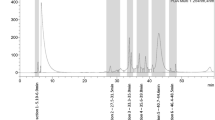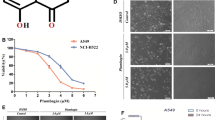Abstract
This study investigated the potential of Persian shallot extract as an anticancer agent in HepG2 tumor cell line, an in vitro human hepatoma cancer model system. The inhibitory effect of Persian shallot on the growth of HepG2 cells was measured by MTT assay. To explore the underlying mechanism of cell growth inhibition of Persian shallot, the activity of Persian shallot in inducing apoptosis was investigated through the detection of annexin V signal by flow cytometry and expression of some apoptosis related genes such p21, p53, puma, caspase-8 family-Bcl-2 proteins like bid, bim, bcl-2 and bax were measured by real-time PCR in HepG2 cells. Persian shallot extract inhibited the growth of HepG2 cells in a dose-dependent manner. The IC50 value (inhibiting cell growth by 50%) was 149 μg/ml. The results of real-time PCR revealed a significant up-regulation of bid, bim, caspase-8, puma, p53, p21 and bax genes and a significant downregulation of bcl-2 gene in HepG2 cells treated with Persian shallot extract significantly. Therefore, this is the first report on an increased expression of bid, bim, caspase-8, puma, p53, p21 and bax genes and down regulation of bcl-2 gene indicating that the Persian shallot extract possibly induced the process of cell death through the intrinsic and extrinsic apoptosis pathways and triggers the programmed cell death in HepG2 tumor cell lines by modulating the expression of pro-/anti-apoptotic genes. Furthermore, we showed that Persian shallot extract increased annexin V signal and expression, resulting in apoptotic cell death of HepG2 cells after 24 h treatment. Therefore, according to the results of this study, the Persian shallot extract could be considered as a potential candidate for production of drug for the prevention or treatment of human hepatoma.





Similar content being viewed by others
Abbreviations
- DMSO:
-
Dimethyl sulfoxide
- FBS:
-
Fetal bovine serum
- FITC:
-
Fluorescein isothiocyanate
- HCC:
-
Hepatocellular carcinoma
- HepG2:
-
Human hepatocellular liver carcinoma cell line
- IC50 :
-
Inhibiting cell growth by 50%
- MTT:
-
3-(4,5-Dimethyl-2-thiazolyl)-2,5-diphenyl-2H-tetrazolium bromide
- PBMC:
-
Peripheral blood mononuclear cells
- PBS:
-
Phosphate buffered saline
- PI:
-
Propidium iodide
- SPSS:
-
Statistical package for the social sciences
References
Al-Fatlawi AA, Al-Fatlawi AA, Irshad M, Zafaryab M, Rizvi M, Ahmad A (2014) Rice bran phytic acid induced apoptosis through regulation of Bcl-2/Bax and p53 genes in HepG2 human hepatocellular carcinoma cells. Asian Pac J Cancer Prev 15:3731–3736
Asgarpanah J, Ghanizadeh B (2012) Pharmacologic and medicinal properties of Allium hirtifolium Boiss. Afr J Pharm Pharmacol 6:1809–1814
Avila MA, Berasain C, Sangro B, Prieto J (2006) New therapies for hepatocellular carcinoma. Oncogene 25:3866–3884
Azadi HG, Ghaffari SM, Riazi GH, Ahmadian S, Vahedi F (2008) Antiproliferative activity of chloroformic extract of Persian Shallot, Allium hirtifolium, on tumor cell lines. Cytotechnology 56:179–185
Azadi HG, Fathi B, Kazemi Mehrjerdi H, Maleki M, Shaterzadeh H, Abyazi M (2012) Macroscopic evaluation of wound healing activity of the Persian shallot, Allium hirtifolium in rat. IJVST 3:31–38
Barile E, Capasso R, Izzo AA, Lanzotti V, Sajjadi SE, Zolfaghari B (2005) Structure-activity relationships for saponins from Allium hirtifolium and Allium elburzense and their antispasmodic activity. Planta Med 71:1010–1018
Desagher S, Osen-Sand A, Nichols A, Eskes R, Montessuit S, Lauper S, Maundrell K, Antonsson B, Martinou JC (1999) Bid-induced conformational change of Bax is responsible for mitochondrial cytochrome c release during apoptosis. J Cell Biol 144:891–901
Ding WX, Ni HM, Chen X, Yu J, Zhang L, Yin XM (2007) A coordinated action of Bax, PUMA, and p53 promotes MG132-induced mitochondria activation and apoptosis in colon cancer cells. Mol Cancer Ther 6:1062–1069
Du P, Cao H, Wu HR, Zhu BS, Wang HW, Gu CW, Xing CG, Chen W (2013) Blocking Bcl-2 leads to autophagy activation and cell death of the HEPG2 liver cancer cell line. Asian Pac J Cancer Prev 14:5849–5854
Fattorusso E, Iorizzi M, Lanzotti V, Taglialatela-Scafati O (2002) Chemical composition of shallot (Allium ascalonicum Hort.). J Agric Food Chem 50:5686–5690
Ferlay J, Soerjomataram I, Dikshit R, Eser S, Mathers C, Rebelo M, Parkin DM, Forman D, Bray F (2015) Cancer incidence and mortality worldwide: sources, methods and major patterns in GLOBOCAN 2012. Int J Cancer 136:E359–E386
Gerl R, Vaux DL (2005) Apoptosis in the development and treatment of cancer. Carcinogenesis 26:263–270
Hetz CA, Torres V, Quest AF (2005) Beyond apoptosis: nonapoptotic cell death in physiology and disease. Biochem Cell Biol 83:579–588
Hosseini J, Hosseini-Zijoud SM, Oubari F, Mahmoodi M, Abbasi Oshaghi E, Rajabi Gilan N, Ghasemi SR, Hashemi B (2012) Hepatoprotective effects of hydroalcoholic extract of Allium hirtifolium (Persian Shallot) in diabetic rats. J Basic Clin Physiol Pharmacol 23:83–87
Hosseini-Zijoud SM, Hosseini J, Mahmoodi M, Behrooz H (2012) The effects of Persian shallot extract on the levels of some blood biochemical parameters in streptozotocin-induced diabetic rats. Afr J Agric Res 7:3308–3313
Ismail S, Jalilian FA, Talebpour AH, Zargar M, Shameli K, Sekawi Z, Jahanshiri F (2013) Chemical composition and antibacterial and cytotoxic activities of Allium hirtifolium Boiss. Biomed Res Int 25:1–9
Jafarian A, Ghannadi A, Elyasi A (2003) The effects of Allium hirtifolium Boiss. on cell mediated immune response in mice. Iran J Pharm Res 2:51–55
Kaseb AO, Abaza YM, Roses RE (2013) Multidisciplinary management of hepatocellular carcinoma. Multidiscip Treat Hepatocell Carcinoma Recent Results Cancer Res 190:247–259
Khalil MI, Ibrahim MM, El-Gaaly GA, Sultan AS (2015) Trigonella foenum (Fenugreek) induced apoptosis in hepatocellular carcinoma cell line, HepG2, mediated by upregulation of p53 and proliferating cell nuclear antigen. Biomed Res Int 2015:914645. doi:10.1155/2015/914645
Kim YS, Li XF, Kang KH, Ryu B, Kim SK (2014) Stigmasterol isolated from marine microalgae Navicula incerta induces apoptosis in human hepatoma HepG2 cells. BMB Rep 47:433–438
Leelarungrayub N, Rattanapanone V, Chanarat N, Gebicki JM (2006) Quantitative evaluation of the antioxidant properties of garlic and shallot preparations. Nutrition 22:266–274
Letai A, Bassik MC, Walensky LD, Sorcinelli MD, Weiler S, Korsmeyer SJ (2002) Distinct BH3 domains either sensitize or activate mitochondrial apoptosis, serving as prototype cancer therapeutics. Cancer Cell 2:183–192
Mahmoodi M, Zarei S, Rezaeian M, Arababadi MK, Ghasemi H, Khoramdelazad H, Rezayati N, Hasanshahi G, Hosseini-Zijoud SM (2013) Persian shallot (Allium hirtifolium Boiss) extract elevates glucokinase (GCK) activity and gene expression in diabetic rats. Am J Plant Sci 4:1393–1399
Ming L, Wang P, Bank A, Yu J, Zhang L (2006) PUMA dissociates Bax and BCL-XL to induce apoptosis in colon cancer cells. J Biol Chem 281:16034–16042
Omobuwajo O, Abdu A, Igbeneghu O, Agboola O, Alade G (2011) Preliminary investigation of a herbal soap incorporating Cassia senna (L) Roxb leaves and Ageratum conyzoides Linn whole plant powders. Cont J Pharm Sci 5:1–10
Raicht RF, Cohen BI, Fazzini EP, Sarwal AN, Takahashi M (1980) Protective effect of plant sterols against chemically induced colon tumors in rats. Cancer Res 40:403–405
Raisova M, Hossini AM, Eberle J, Riebeling C, Orfanos CE, Geilen CC, Wieder T, Sturm I, Daniel PT (2001) The Bax/Bcl-2 ratio determines the susceptibility of human melanoma cells to CD95/Fas-mediated apoptosis. J Invest Dermatol 117:333–340
Rose P, Whiteman M, Moore PK, Zhu YZ (2005) Bioactive S-alk (en) yl cysteine sulfoxide metabolites in the genus Allium: the chemistry of potential therapeutic agents. Nat Prod Rep 22:351–368
Shahneh FZ, Valiyari S, Azadmehr A, Hajiaghaee R, Bandehagh A, Baradaran B (2013) Cytotoxic activities of Ferulago angulata extract on human leukemia and lymphoma cells by induction of apoptosis. J Med Plants Res 7:677–682
Song HY, Deng XH, Yuan GY, Hou XF, Zhu ZD, Zhou L, Ren MX (2014) Expression of bcl-2 and p53 in Induction of esophageal cancer cell apoptosis by ECRG2 in combination with cisplatin. Asian Pac J Cancer Prev 15:1397–1401
Taran M, Rezaeian M, Izaddoost M (2006) In vitro antitrichomonas activity of Allium hirtifloium (Persian Shallot) in comparison with metronidazole. Iranian J Publ Health 35:92–94
Tavakkol-Afshari J, Brook A, Mousavi SH (2008) Study of cytotoxic and apoptogenic properties of saffron extract in human cancer cell lines. Food Chem Toxicol 46:3443–3447
van Engeland M, Nieland LJ, Ramaekers FC, Schutte B, Reutelingsperger CP (1998) Annexin V-affinity assay: a review on an apoptosis detection system based on phosphatidylserine exposure. Cytometry 31:1–9
Villunger A, Michalak EM, Coultas L, Müllauer F, Böck G, Ausserlechner MJ, Adams JM, Strasser A (2003) p53-and drug-induced apoptotic responses mediated by BH3-only proteins puma and noxa. Science 302:1036–1038
Yu Q (2006) Restoring p53-mediated apoptosis in cancer cells: new opportunities for cancer therapy. Drug Resist Updat 9:19–25
Yu J, Zhang L, Hwang PM, Kinzler KW, Vogelstein B (2001) PUMA induces the rapid apoptosis of colorectal cancer cells. Mol Cell 7:673–682
Zhang Y, Yao HP, Huang FF, Wu W, Gao Y, Chen ZB, Liang ZY, Liang TB (2008) Allicin, a major component of garlic, inhibits apoptosis in vital organs in rats with trauma/hemorrhagic shock. Crit Care Med 36:3226–3232
Acknowledgements
This project was financially supported by a Grant (20/414) from the Rafsanjan University of Medical Sciences. The authors thank the Molecular Medicine Research Center (MMRC) from Rafsanjan University of Medical Sciences (RUMS) of Iran for providing the necessary equipment of this work. The support of vice chancellor to research of RUMS is acknowledged.
Author information
Authors and Affiliations
Corresponding author
Ethics declarations
Conflict of interest
We declare that we have no conflict of interest.
Rights and permissions
About this article
Cite this article
Hosseini, F.S., Falahati-pour, S.K., Hajizadeh, M.R. et al. Persian shallot, Allium hirtifolium Boiss, induced apoptosis in human hepatocellular carcinoma cells. Cytotechnology 69, 551–563 (2017). https://doi.org/10.1007/s10616-017-0093-4
Received:
Accepted:
Published:
Issue Date:
DOI: https://doi.org/10.1007/s10616-017-0093-4




